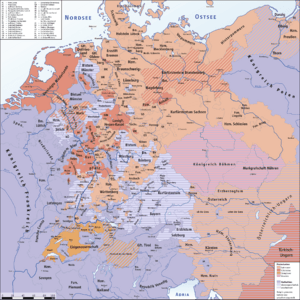Protestant Union facts for kids


The Protestant Union (German: Protestantische Union) was a group of German states that joined together. They were all Protestant, meaning they followed a branch of Christianity different from Catholicism. This union was formed on May 14, 1608, by Frederick IV, Elector Palatine. Its main goal was to protect the rights, land, and safety of its members. The Union included both Calvinist and Lutheran states. It lasted for about 13 years, dissolving in 1621.
Contents
Why the Union Was Formed
The Protestant Union was created because of two main events. First, in 1607, the Holy Roman Emperor Rudolf II and Bavarian Duke Maximilian I brought Catholicism back to the city of Donauwörth. This worried the Protestant states.
Second, by 1608, many leaders in the Imperial Diet (a kind of parliament) wanted to renew the 1555 Peace of Augsburg. This peace treaty allowed princes to choose the religion of their state. However, they wanted to add a condition: all church land taken since 1552 had to be returned. Protestant princes did not agree with this.
Because of these issues, Protestant princes met in Auhausen. There, on May 14, 1608, they formed the Protestant Union. Frederick IV, Elector Palatine became its leader. In response, the Catholic League was formed the next year, led by Duke Maximilian.
Who Joined the Protestant Union?
Many states and cities became members of the Protestant Union. These included:
- The Palatinate
- Württemberg
- Hesse-Kassel
- Brandenburg
- And many free cities like Ulm, Strasbourg, and Nuremberg.
However, some powerful Protestant rulers, like the Elector of Saxony, did not join. This made the Union weaker from the start. Also, there were often disagreements between the Lutheran and Calvinist members within the Union.
How the Union Ended
In 1619, Frederick V of the Palatinate accepted the crown of Bohemia. This was against the wishes of Holy Roman Emperor Ferdinand II. This event helped start the Thirty Years' War.
On July 3, 1620, the Protestant Union signed the Treaty of Ulm (German: Ulmer Vertrag). In this treaty, they decided to stay neutral and not support Frederick V in his fight against the Emperor.
In January 1621, Emperor Ferdinand II took strong action against Frederick V. He banned Frederick from the empire and gave his right to elect an emperor to Maximilian. Frederick's land, the Upper Palatinate, was also given to Bavaria.
The Protestant Union met in Heilbronn in February to protest Ferdinand's actions. But the Emperor ignored their complaints. He ordered the Protestant Union to disband its army. The members agreed to this demand in May. On May 14, 1621, the Protestant Union was officially dissolved.
A new group, the Heilbronn League, was formed twelve years later. It was not connected to the Protestant Union. This new league joined some Protestant states in Germany. They fought against the Holy Roman Emperor with help from Sweden and France.
Rules of the Protestant Union
The Protestant Union was formed to make the Peace of Augsburg stronger and safer for Protestants. Its leaders created these important rules and agreements for all members:
- Each member promised to be loyal to the Union, their families, land, and people. No one was allowed to join other alliances.
- Members agreed to share secret information. This was to warn each other about any dangers or attacks that might threaten their families, land, or people. They promised to stay in close contact.
- If important issues came up that affected the Union's well-being, members would help each other with good advice. They wanted to support everyone as much as possible.
- The Union's wishes about the freedoms and rights of German Electors and states should be clearly stated at official meetings. They should not just be discussed in secret.
- The Union agreed that disagreements about religion would not stop them from supporting each other. No member was allowed to attack another in books or sermons. They also agreed not to cause any breaks in the peace. However, religious scholars could still discuss and debate God's word.
- If one member of the Union was attacked, all other members promised to immediately help with all the Union's resources.
Important Dates
- 1555: The Peace of Augsburg was signed. This treaty allowed Catholic and Lutheran princes to choose their state's religion. However, it did not protect Calvinist princes.
- 1608: Protestant princes formed the Protestant Union.
- 1609: The Catholic League was created in response.
- 1610: The Union got involved in the War of the Jülich Succession.
- 1618: The Thirty Years' War began with the Bohemian Revolt.
- 1619: Frederick V, Elector Palatine, accepted the crown of Bohemia.
- 1620: The Union declared it would stay neutral in the conflict between Frederick and the Catholic League in the Treaty of Ulm.
- 1621: The Protestant Union officially dissolved.
See also
 In Spanish: Unión Protestante para niños
In Spanish: Unión Protestante para niños
- Other Protestant groups:
- League of Torgau (1526-1531), an early group of Protestant princes against the Catholic League of Dessau. It was followed by the Schmalkaldic League.
- Schmalkaldic League (1531-1546), a group of Protestant princes against the Holy Roman Emperor.
- Heilbronn League (1633-1648), a group of western and southern Protestant German states supported by Sweden and France.


